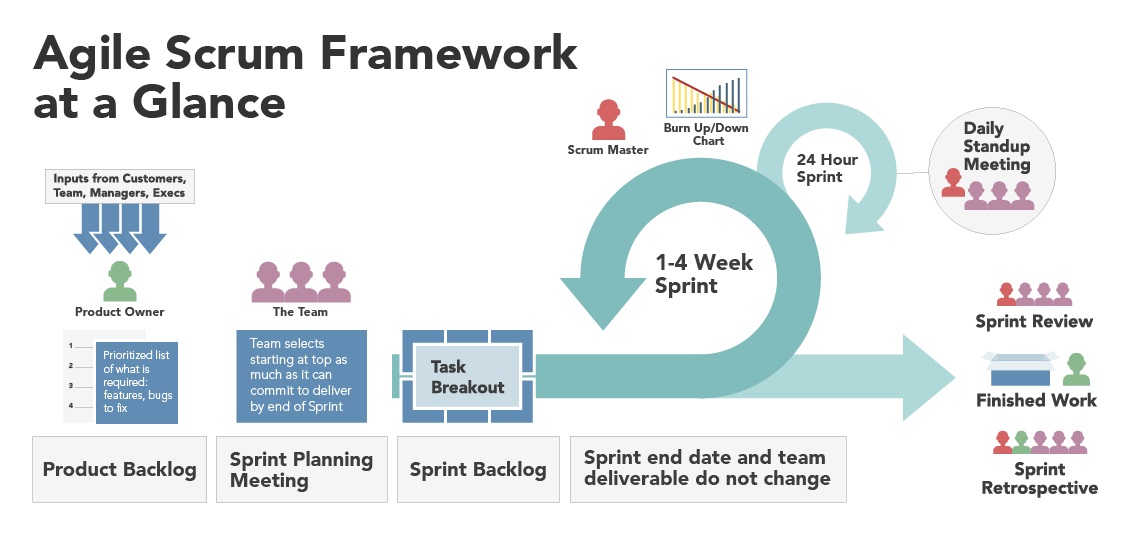Business Solutions Implementation
We follow the proven Agile methodology to implement business solutions and technologies. Together with industry best practices, the methodology provides stakeholder engagement, transparency, early and predictable delivery, predictable costs and schedule.
Agile methodology also allows for change and focuses on business value and users. It also improves the quality. Salient benefits are mentioned as below.
Stakeholder Engagement
Agile provides multiple opportunities for stakeholder and team engagement – before, during, and after each Sprint. By involving the client in every step of the project, there is a high degree of collaboration between the client and project team, providing more opportunities for the team to truly understand the client’s vision. Delivering working software early and frequently increases stakeholders’ trust in the team’s ability to deliver high-quality working software and encourages them to be more deeply engaged in the project.
Transparency
An Agile approach provides a unique opportunity for clients to be involved throughout the project, from prioritizing features to iteration planning and review sessions to frequent software builds containing new features. However, this also requires clients to understand that they are seeing a work in progress in exchange for this added benefit of transparency.
Early and Predictable Delivery
By using time-boxed, fixed schedule Sprints of 1-4 weeks, new features are delivered quickly and frequently, with a high level of predictability. This also provides the opportunity to release or beta test the software earlier than planned if there is sufficient business value.
Predictable Costs and Schedule
Because each Sprint is a fixed duration, the cost is predictable and limited to the amount of work that can be performed by the team in the fixed-schedule time box. Combined with the estimates provided to the client prior to each Sprint, the client can more readily understand the approximate cost of each feature, which improves decision making about the priority of features and the need for additional iterations.
Allows for Change
While the team needs to stay focused on delivering an agreed-to subset of the product’s features during each iteration, there is an opportunity to constantly refine and reprioritize the overall product backlog. New or changed backlog items can be planned for the next iteration, providing the opportunity to introduce changes within a few weeks.
Focuses on Business Value
By allowing the client to determine the priority of features, the team understands what’s most important to the client’s business, and can deliver the features that provide the most business value.
Focuses on Users
Agile commonly uses user stories with business-focused acceptance criteria to define product features. By focusing features on the needs of real users, each feature incrementally delivers value, not just an IT component. This also provides the opportunity to beta test software after each Sprint, gaining valuable feedback early in the project and providing the ability to make changes as needed.
Improves Quality
By breaking down the project into manageable units, the project team can focus on high-quality development, testing, and collaboration. Also, by producing frequent builds and conducting testing and reviews during each iteration, quality is improved by finding and fixing defects quickly and identifying expectation mismatches early.
During Segue’s own experience of adopting Agile software development practices, we have seen solutions delivered on time and with a higher degree of client and customer satisfaction. By incorporating the ability to change, we have been able to better incorporate feedback from demos, usability testing, and client and customer feedback.
Agile is a powerful tool for software development, not only providing benefits to the development team, but also providing a number of important business benefits to the client. Agile helps project teams deal with many of the most common project pitfalls (such as cost, schedule predictability and scope creep) in a more controlled manner. By reorganizing and re-envisioning the activities involved in custom software development, Agile achieves those same objectives in a leaner and more business-focused way.
Newsletter
YouTube Training Videos
- Procure to pay - An end-to-end process
- Order to cash process - An end-to-end process
- How to post vendor invoices in batch
- Accrual Schemes for Payable
- Quote to bill in Project Management and Accounting
- How to run master planning on Min/Max coverage code
- Embedded Power BI Analytics in Dynamics 365 F&O
- Configuring IS with periodic trend in Financial reports
- Reversing a purchase invoice in SAP S4 Hana and D365 F&O
Services Provided
- D365 F&O Implementation / Support
- D365 F&O Customizations
- CRM Implementation
- Helpdesk System Implementation
- Website Implementation
- Odoo ERP Implementation
- LMS Implementation
- Survey Implementation
- Power BI / Apps Implementation